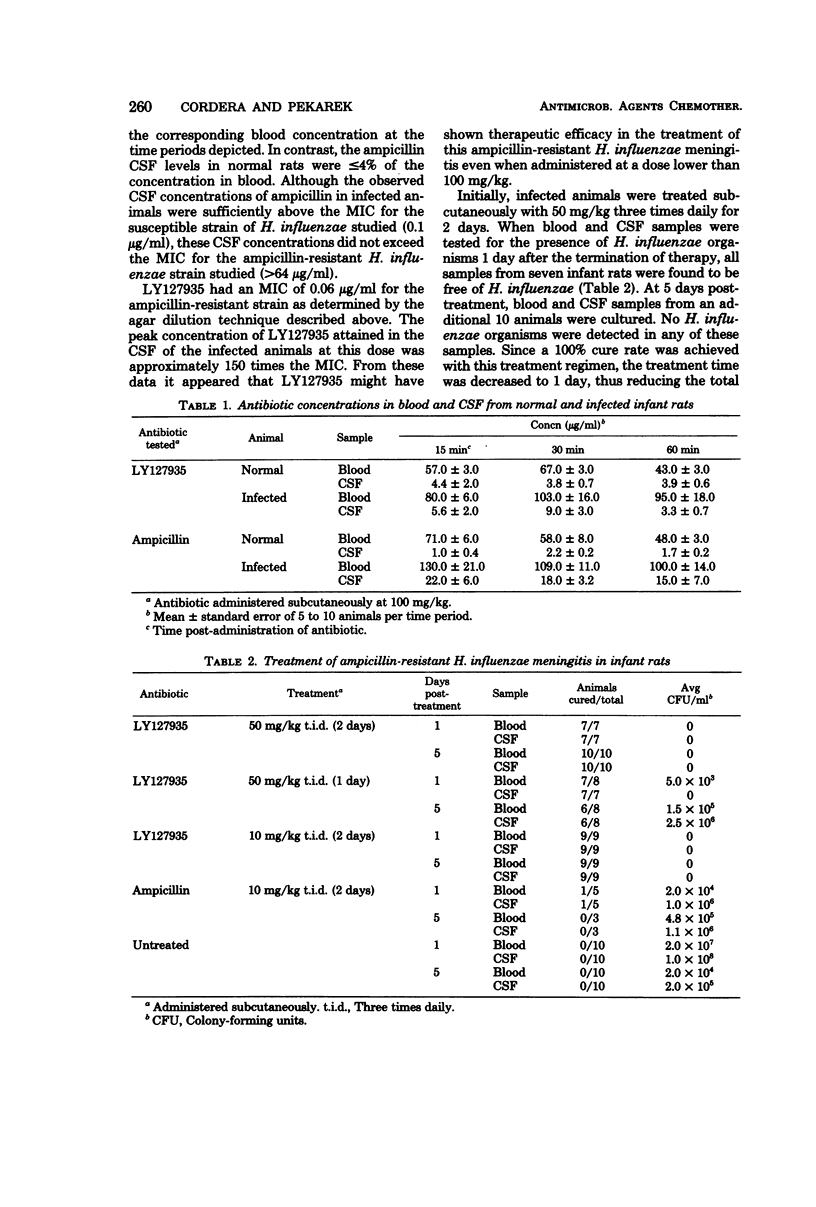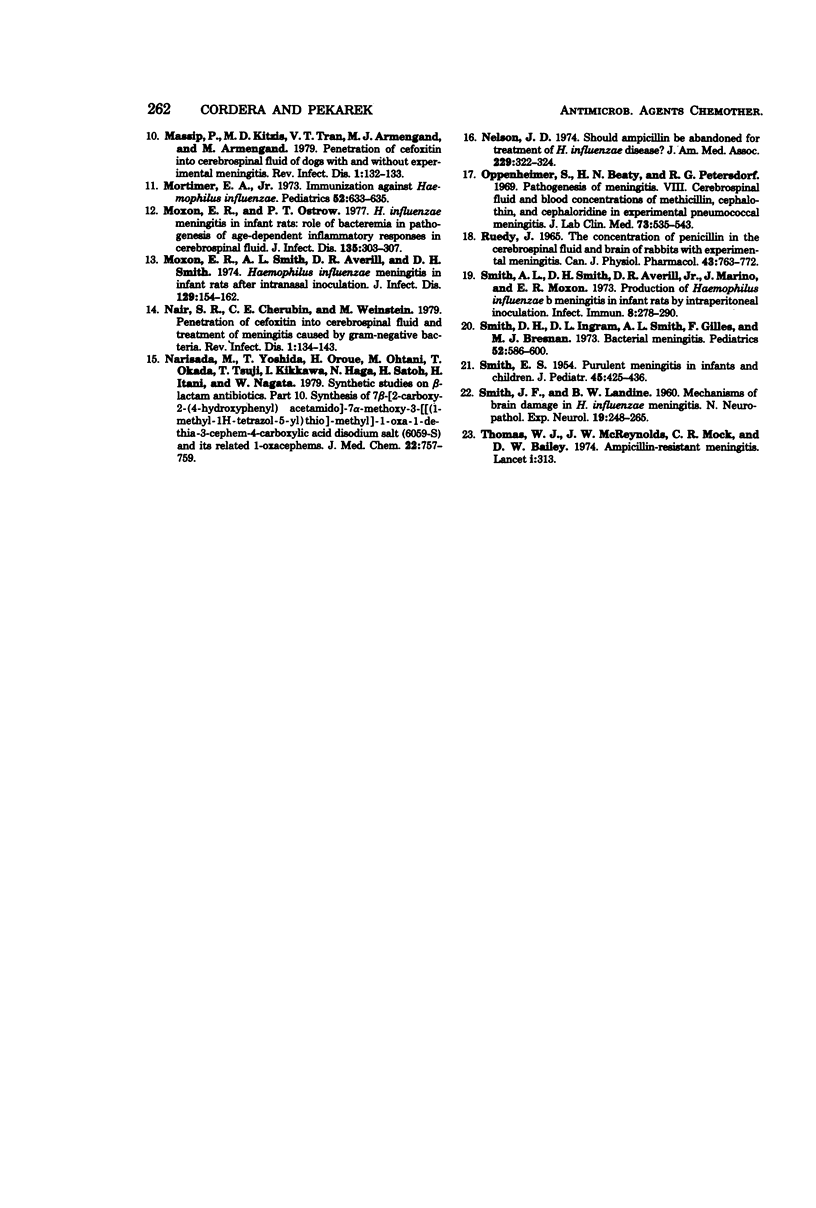Abstract
1-Oxa-beta-lactam (LY127935) (Shionogi 6059-S) is a new type beta-lactam antibiotic having a broad spectrum of antibacterial activity. It is highly active against ampicillin-resistant strains of Haemophilus influenzae exhibiting minimal inhibitory concentrations as low as 0.06 microgram/ml. This compound also has the ability to penetrate into the cerebrospinal fluid of both normal and infected infant rats and attains approximately 10% of the corresponding blood levels. LY127935 was evaluated for its ability to treat ampicillin-resistant H. influenzae meningitis in an established experimental model using infant rats. Rats with ampicillin-resistant H. influenzae meningitis were treated subcutaneously three times daily for 2 days with various dose levels of LY127935. When given in doses as low as 10 mg/kg, LY127935 sterilized the blood and cerebrospinal fluid in all rats examined at 1 and 5 days posttreatment. In contrast, ampicillin was not effective at this dose in eliminating H. influenzae from the blood and cerebrospinal fluid of infected rats. LY127935 was effective against experimental ampicillin-resistant H. influenzae meningitis in the dosages employed.
Full text
PDF




Selected References
These references are in PubMed. This may not be the complete list of references from this article.
- Beam T. R., Jr, Allen J. C. Blood, brain, and cerebrospinal fluid concentrations of several antibiotics in rabbits with intact and inflamed meninges. Antimicrob Agents Chemother. 1977 Dec;12(6):710–716. doi: 10.1128/aac.12.6.710. [DOI] [PMC free article] [PubMed] [Google Scholar]
- Bodine J. A., Strausbaugh L. J., Sande M. A. Ampicillin and an ester in experimental Hemophilus influenzae meningitis. Clin Pharmacol Ther. 1976 Dec;20(6):727–732. doi: 10.1002/cpt1976206727. [DOI] [PubMed] [Google Scholar]
- CARPENTER R. R., PETERSDORF R. G. The clinical spectrum of bacterial meningitis. Am J Med. 1962 Aug;33:262–275. doi: 10.1016/0002-9343(62)90024-4. [DOI] [PubMed] [Google Scholar]
- Kaiser A. B., McGee Z. A. Aminoglycoside therapy of gram-negative bacillary meningitis. N Engl J Med. 1975 Dec 11;293(24):1215–1220. doi: 10.1056/NEJM197512112932401. [DOI] [PubMed] [Google Scholar]
- Khan W., Ross S., Rodriguez W., Controni G., Saz A. K. Haemophilus influenzae type B resistant to ampicillin. A report of two cases. JAMA. 1974 Jul 15;229(3):298–301. [PubMed] [Google Scholar]
- Liu C., Hinthorn D. R., Hodges G. R., Harms J. L., Couchonnal G., Dworzack D. L. Penetration of cefoxitin into human cerebrospinal fluid: comparison with cefamandole, ampicillin, and penicillin. Rev Infect Dis. 1979 Jan-Feb;1(1):127–131. doi: 10.1093/clinids/1.1.127. [DOI] [PubMed] [Google Scholar]
- Massip P., Kitzis M. D., Tran V. T., Armengaud M. J., Armengaud M. Penetration of cefoxitin into cerebrospinal fluid of dogs with and without experimental meningitis. Rev Infect Dis. 1979 Jan-Feb;1(1):132–133. doi: 10.1093/clinids/1.1.132. [DOI] [PubMed] [Google Scholar]
- Mortimer E. A., Jr Commentary: Immunization against Haemophilus influenzae. Pediatrics. 1973 Nov;52(5):633–635. [PubMed] [Google Scholar]
- Moxon E. R., Ostrow P. T. Haemophilus influenzae meningitis in infant rats: role of bacteremia in pathogenesis of age-dependent inflammatory responses in cerebrospinal fluid. J Infect Dis. 1977 Feb;135(2):303–307. doi: 10.1093/infdis/135.2.303. [DOI] [PubMed] [Google Scholar]
- Moxon E. R., Smith A. L., Averill D. R., Smith D. H. Haemophilus influenzae meningitis in infant rats after intranasal inoculation. J Infect Dis. 1974 Feb;129(2):154–162. doi: 10.1093/infdis/129.2.154. [DOI] [PubMed] [Google Scholar]
- Nair S. R., Cherubin C. E., Weinstein M. Penetration of cefoxitin into cerebrospinal fluid and treatment of meningitis caused by gram-negative bacteria. Rev Infect Dis. 1979 Jan-Feb;1(1):134–143. doi: 10.1093/clinids/1.1.134. [DOI] [PubMed] [Google Scholar]
- Narisada M., Yoshida T., Onoue H., Ohtani M., Okada T., Tsuji T., Kikkawa I., Haga N., Satoh H., Itani H. Synthetic studies on beta-lactam antibiotics. Part 101. Synthesis of 7beta-[2-carboxy-2-(4-hydroxyphenyl)acetamido]-7alpha-methoxy-3-[[(1-methyl-1H-tetrazol-5-yl)thio]-methyl]-1-oxa-1-dethia-3-cephem-4-carboxylic acid disodium salt (6059-S) and its related 1-oxacephems. J Med Chem. 1979 Jul;22(7):757–759. doi: 10.1021/jm00193a001. [DOI] [PubMed] [Google Scholar]
- Nelson J. D. Editorial: Should ampicillin be abandoned for treatment of Haemophilus influenzae disease? JAMA. 1974 Jul 15;229(3):322–324. [PubMed] [Google Scholar]
- Oppenheimer S., Beaty H. N., Petersdorf R. G. Pathogenesis of meningitis. VIII. Cerebrospinal fluid and blood concentrations of methicillin, cephalothin, and cephaloridine in experimental pneumococcal meningitis. J Lab Clin Med. 1969 Apr;73(4):535–543. [PubMed] [Google Scholar]
- SMITH E. S. Purulent meningitis in infants and children; a review of 409 cases. J Pediatr. 1954 Oct;45(4):425–436. doi: 10.1016/s0022-3476(54)80167-3. [DOI] [PubMed] [Google Scholar]
- Smith A. L., Smith D. H., Averill D. R., Jr, Marino J., Moxon E. R. Production of Haemophilus influenzae b meningitis in infant rats by intraperitoneal inoculation. Infect Immun. 1973 Aug;8(2):278–290. doi: 10.1128/iai.8.2.278-290.1973. [DOI] [PMC free article] [PubMed] [Google Scholar]
- Smith D. H., Ingram D. L., Smith A. L., Gilles F., Bresnan M. J. Bacterial meningitis. A symposium. Pediatrics. 1973 Oct;52(4):586–600. [PubMed] [Google Scholar]
- Thomas W. J., McReynolds J. W., Mock C. R., Bailey D. W. Letter: Ampicillin-resistant Haemophilus influenzae meningitis. Lancet. 1974 Feb 23;1(7852):313–313. doi: 10.1016/s0140-6736(74)92617-8. [DOI] [PubMed] [Google Scholar]


